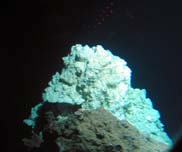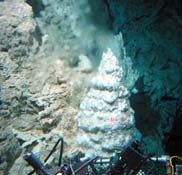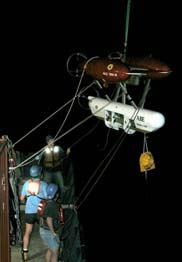|
|
|||||||||||||||||||||||||||||||||||||||||||||||||||||||||||||||||||||||||||||||||||||||||||||||||||
 |
|||||||||||||||||||||||||||||||||||||||||||||||||||||||||||||||||||||||||||||||||||||||||||||||||||
It was with a bit of anxiousness and lots of excitement that I climbed back into Alvin for the first time in nearly three years to visit the Lost City Field again. All the planning and hard work by a lot of people was focused into yesterday morning. Mainly I wondered, "Would we be able to find the vents again without hours of wandering around the Atlantis Mountain?". Pilot Bruce Strickrott and biologist Tim Shanks were also on the dive and our goals were to find the field, conduct an initial exploration, and take a suite of rock, fluid, and biological samples. By 0800 Alvin was in the water. With only 25-30 minutes of descent time (instead of the typical 1-1 1/2 hours in other areas), we had to rapidly stow our gear and get our minds set to explore th field. As the sub was lowered into the water, the windows were engulfed in a familiar wash of bright blue water. Upon descent, this rapidly changed into darkness and small bioluminescent organisms with fantastically diverse shapes floated by the windows. It looked like hundreds of stars on a clear night. By 8:30 AM we were on the bottom and Bruce began an array of instrument tests to make sure everything on the submersible was working well.
With great relief, within about 10 minutes we had come upon the monster tower called Poseidon, the nearly 200 foot tall structure that we had first visited in 2000. We ascended to the top of the edifice and visited two of the active pinnacles where Bruce obtained fluids, rocks, and biological samples for us using the two manipulator arms of Alvin. With Tim onboard, I got to learn about some of the amazing animals that live around the vents. For example, there are swarms of flea-like critters called amphipods and small shrimp that dart in and out of the field of view. Because we did not yet have a map of the field, there was a lot of discussion between the three of us about what we were each seeing and where we thought we had been.
In many ways the landscape that we visited left me in even more awe than the discovery dive. This area must be one of the most remarkable places on Earth, but it is difficult to describe. The field is extremely complex with vertical spires that rise up farther than you can see, bounded by rock cliffs that extend downward for hundreds of feet. Out of the sides of the cliffs are delicate, snow-white carbonate deposits that look like upturned hands--each finger composed of numerous delicate intergrowths. In other places along the wall, huge white carbonate pinnacles rise vertically for many tens of feet--their pointy tops rise up above the platform or bench that much of the field lies on. We saw structures that looked like the magic rocks we grew in fish bowls as kids, and encountered gigantic pieces of chimneys that had toppled from above and slid down the steep cliff faces. White intertwining scars marked places of recent venting along the sides of the towers. It was a rare, remarkable experience that I will remember for a long time. We surfaced at 3:45 grinning ear to ear, with a basket load of samples.
The anxiousness and excitement for the day, however, had not yet ended because after the dive, the free-swimming robotic vehicle ABE was scheduled for its first dive. Dana Yoerger, Al Bradley, Rod Catanach and Mike Jakuba worked feverishly to get ABE ready and in the water for its first mapping exercise of the expedition. After exhaustive testing and careful leadership by the Bosun Wayne, ABE was deployed into the waves. Its flashing beacon lit the night as it slowly submerged under the white caps, and ABE dove beneath the seas to begin a night of detailed mapping. Just as with the dive to Lost City, this was a most memorable experience. ABE being deployed by members of the crew and ABE team. A large crane lifted it over the port side, while the team held ropes to steady the vehicle as it was picked up and lowered into the water. |
|||||||||||||||||||||||||||||||||||||||||||||||||||||||||||||||||||||||||||||||||||||||||||||||||||



